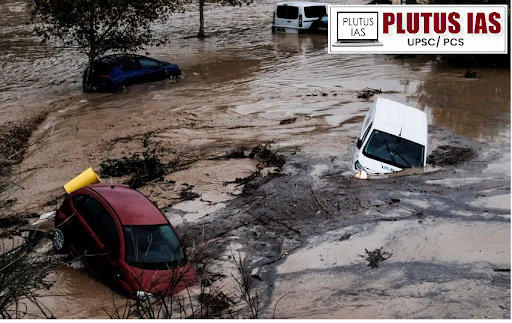05 Nov Depresión Aislada en Niveles Altos (DANA) weather system
This article covers “Daily Current Affairs” and topic details Depresión Aislada en Niveles Altos (DANA) weather system
Syllabus mapping:
GS-3: Environment: Disaster management
For Prelims:
What is the DANA weather system? Its impact on the local weather
For Mains:
What is the mechanism of the formation of the DANA weather system, its consequences, and measures to reduce its impacts?
Why in the news?
Eastern Spain recently experienced extreme weather conditions, with Valencia receiving a year’s worth of rainfall in just eight hours due to a phenomenon known locally as Depresión Aislada en Niveles Altos (DANA). This intense weather event results from cold air trapped at high altitudes mixing with warm, humid air near the surface, creating heavy rainfall and severe storms in a short period.

What is a DANA System?
A DANA (Depresión Aislada en Niveles Altos) is a severe weather system associated with intense rainfall and flooding. It occurs when a mass of warm surface air collides with a stagnant cold air mass in the upper atmosphere, around 9,000 meters (29,500 feet) high, creating a dramatic temperature contrast and resulting in heavy, concentrated rainfall.
Mechanism of DANA Formation
Upper-Atmosphere Instability: Strong, belt-like wind currents in the upper atmosphere, such as the jet stream, occasionally oscillate and become “stuck” over certain areas, trapping cold air masses in one place. This often occurs over southeastern Spain.
Temperature Contrast and Rising Warm Air: A sharp temperature difference occurs when this cold upper air mass encounters very warm, moist surface air (often from the Mediterranean after summer). This causes the warm, humid air to rise rapidly.
Intense Storms and Rainfall: The warm Mediterranean waters contribute humidity and energy, intensifying storm activity. This leads to torrential rains and severe weather that can surpass the intensity of a typical hurricane in terms of rainfall.
Consequences of a DANA System
Flooding: Torrential rains often overwhelm drainage systems, leading to flash floods, river overflows, and waterlogging in urban areas. Flooding can result in significant damage to homes, infrastructure, and agriculture.
Landslides: Excessive rainfall saturates the soil, increasing the risk of landslides, especially in mountainous or hilly areas. Landslides can block roads, damage property, and pose risks to lives.
Economic Losses: Flood damage to buildings, infrastructure, and crops leads to substantial economic costs. Recovery efforts are often prolonged and costly.
Casualties and Displacement: DANA events can cause injuries, fatalities, and forced evacuations. Intense storms and flash floods can catch residents off guard, posing risks to human life and well-being.
Environmental Impact: Intense rainfall and flooding can disturb local ecosystems, lead to soil erosion, and pollute water bodies with runoff containing chemicals and debris.
Measures to Reduce DANA’s Impact
Improved Weather Forecasting and Early Warning Systems: Enhanced meteorological monitoring can provide early warnings to affected regions, allowing residents and authorities to prepare for incoming storms.
Flood Control Infrastructure: Building reservoirs, flood walls, and improved drainage systems can help manage and direct floodwaters to minimize impact. River dredging can also prevent overflow.
Sustainable Urban Planning: Designing cities with green spaces, permeable surfaces, and stormwater management systems reduces water runoff and decreases urban flooding risk.
Public Awareness and Emergency Preparedness: Educating the public on flood risks, safety measures, and evacuation protocols is essential. Regular emergency drills and preparedness campaigns can increase community resilience.
Environmental Management and Reforestation: Restoring vegetation in watersheds and planting trees can stabilize soil, reduce runoff, and lessen landslide risks. Reforestation efforts help absorb excess rainwater and limit soil erosion.
Climate Adaptation Strategies: Reducing greenhouse gas emissions, protecting natural buffers like wetlands, and developing climate-adaptive policies help mitigate the underlying drivers of extreme weather events, including DANAs.
Conclusion:
Effectively managing DANA impacts requires key strategies: understanding DANA systems for early identification of risk zones, building resilient infrastructure like flood controls, and educating communities on safety protocols for rapid response. Protecting natural barriers (forests and wetlands) aids in absorbing rainfall, and reducing environmental harm, while climate-resilient policies and sustainable urban planning ensure long-term preparedness against future DANA events.
Download plutus ias current affairs (Eng) 5th Nov 2024
Prelims question:
Q. Which of the following best describes a DANA (Depresión Aislada en Niveles Altos) system?
A) A phenomenon where a cold air mass collides with warm surface air, creating intense rainfall and storms.
B) A high-altitude system that reduces temperatures by blocking warm air currents.
C) A type of wind pattern that consistently brings mild weather to coastal regions.
D) A tropical cyclone that forms exclusively over the Mediterranean Sea.
Answer: A
Mains question:
Q.Explain the DANA (Depresión Aislada en Niveles Altos) weather phenomenon and discuss its mechanism of formation. How does it differ from other extreme weather systems like hurricanes?
(Answer in 250 words)



No Comments